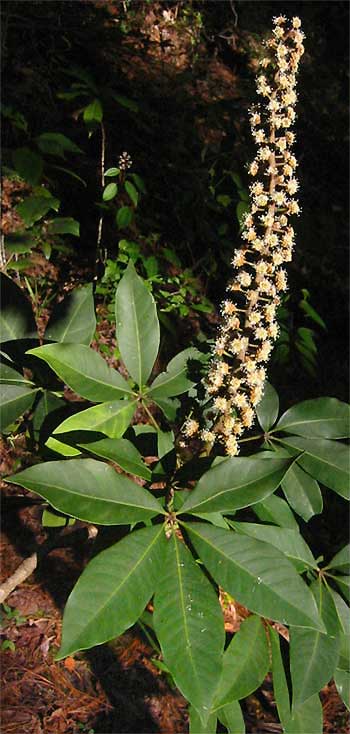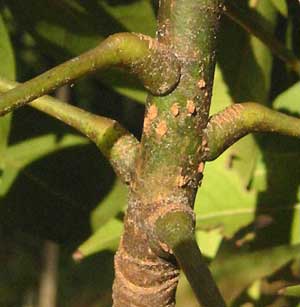Excerpts from Jim Conrad's
Naturalist Newsletter
from the December 10, 2007 Newsletter issued from Yerba Buena Clinic just outside Pueblo Nuevo Solistahuacan, Chiapas, MÉXICO
about 1740 meters in elevation, ± LAT. 17° 11' 27"N, LONG. -92° 53' 35"W
OREOPANAX PELTATUS
An unusual tree was flowering that day, as seen below:

That's an OREOPANAX PELTATUS, a member of the Aralia Family, along with North America's Ginseng and the very spiny Devils-Walking-Stick or Hercules Club. Though Oreopanax's vegetative parts don't look much like either of those, the flowers are of typical Aralia-Family construction, which means that, like flowers of the closely related Parsley Family, blossoms have one inferior ovary topped by typically five petals, and five stamens arise from a ring-like thing called a disk, best seen with magnification. In both the Aralia and Parsley Families, flowers are small, greenish or whitish, and usually are clustered in umbels or umbellate heads, an umbel being a typically flat-topped cluster whose individual flower stems, or pedicels, arise from a common point, like an umbrella's stays. To be flat-toped, flowers at the edge of an umbellate cluster need longer pedicels than those at the cluster's center. A close-up showing a few of our plant's many umbels, arranged in a spike, is shown below:

The Aralia Family is different from the Parsley Family in that ovaries of blossoms in the Aralia Family usually possess more than the Parsley's Family two styles, Aralia Family fruits tend to be grapelike, instead of the Parsley Family's often flattish, dry and ribbed appearance, and Aralia Family species tend to be woodier than those in the Parsley Family.
This Oreopanax's leaves are "digitally compound" -- leaflets arising from the tip of a petiole in the manner of a hand's "digits." You might be interested in seeing what Oreopanax's evergreen leaves' petiole bases look like, shown below:

Note their stout, cylindrical form, as opposed to the wide but narrow, or shield-shaped petiole bases typical of woody, deciduous species in the Temperate Zone. Clearly, these petiole bases plan to remain attached for a long time. In the tropics you often see such petioles on broadleaf evergreen trees.
Five species of Oreopanax are listed for the reserve.
The "oreo" in Oreopanax means "mountain." "Panax" is from classical Greek, meaning "all-healing," as in the word sharing the same root, "panacea."